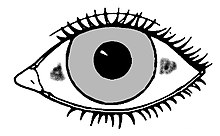Bitot's spots
Appearance
| Bitot's spots | |
|---|---|
| Other names | ICD10 = E50.1 |
 | |
| Typical location of Bitot's spots | |
| Specialty | Ophthalmology |
Bitot's spots are the buildup of keratin located superficially in the conjunctiva of human´s eyes. They can be oval, triangular or irregular in shape. The spots are a sign of vitamin A deficiency and associated with drying of the cornea. In 1863, the French physician Pierre Bitot (1822-1888) first described these spots.[1] The spots may abate under replacement therapy.[2] In ancient Egypt, this was treated with animal liver, which is where vitamin A is stored.[3]
References
- ^ Shukla, M; Behari, K (Jul 1979). "Congenital Bitot spots". Indian Journal of Ophthalmology. 27 (2): 63–4. PMID 541036.
- ^ J. Ram and J. Jinagal Bitot’s Spots August 30, 2018, N Engl J Med 379:869.
- ^ Numitor, Gerd (February 2012). Bitot's Spots. Flu Press. ISBN 978-620-0-57824-2.
External links
